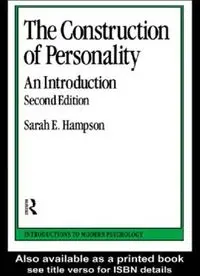
The Construction of Personality : An Introduction (Introductions to Modern Psychology) PDF
Preview The Construction of Personality : An Introduction (Introductions to Modern Psychology)
The construction of personality The Author Until recently, Sarah E. Hampson was a lecturer in psychology at Birkbeck College, University of London. She is now at the Oregon Research Institute in the USA, where she is conducting research in personality and social cognition. She has served on the editorial boards of the British Journal of Social Psychology, the European Journal of Personality, and Personal and Individual Differences. She was the founding secretary of the European Association for Personality Psychology, established in 1984. Introductions to Modern Psychology General Editor: Max Coltheart Birkbeck College, University of London Animal Learning: An Introduction Stephen Walker Artificial Intelligence: An Introduction Alan Garnham Clinical Psychopathology: An Introduction E.M. Coles Consistency in Cognitive Social Behaviour: An Introduction to Social Psychology C.J. Mower White Introduction to Human Memory Vernon H. Gregg Language Processing in Children and Adults: An Introduction Margaret Harris and Max Coltheart Physiological Psychology: An Introduction Simon Green The construction of personality An introduction Second edition Sarah E. Hampson London and New York First published in 1982 by Routledge Second edition published in 1988 by Routledge 11 New Fetter Lane, London EC4P 4EE Published in the USA by Routledge 29 West 35th Street, New York, NY 10001 This edition published in the Taylor & Francis e-Library, 2001. © Sarah E. Hampson, 1982, 1988 No part of this book may be reproduced in any form without permission from the publisher except for the quotation of brief passages in criticism Library of Congress Cataloging in Publication Data Hampson, Sarah E. 1951- The construction of personality. (Introductions to modern psychology) Bibliography: p. Includes indexes. 1. Personality. 2. Personality Research. I. Title. II. Series BF698.11333 1988 155.2 87-12875 British Library CIP Data also available ISBN 0-415-00256-7 (Print Edition) ISBN 0-203-13695-0 Master e-book ISBN ISBN 0-203-17552-2 (Glassbook Format) Contents Acknowledgments vii 1 The concept of personality 1 Part One Explicit Personality: The Personality Theorist’s Perspective 2 Single-trait theories 13 3 Multi-trait theories 40 4 Personality and consistency 72 Part Two Implicit Personality: The Lay Perspective 5 The lay perspective 101 6 Implicit versus explicit personality theories 134 Part Three The Self Perspective and Personality Construction 7 The self perspective 163 8 The construction of personality 191 Part Four Applications of the Constructivist Approach 9 Personality over the life-span 209 10 Criminal personality 249 Bibliography 281 v vi Contents Author index 310 Subject index 316 Acknowledgments First edition A number of people have read some or all of this book at different stages in its preparation and their reactions have been invaluable. I am especially indebted to Max Coltheart for his help with the entire manuscript and to Camilla Mower White who also commented on all the chapters. In particular, I would like to thank Paul Harris for his candid comments. I am also grateful to Mary Boyle, Gordon Craig, Peter Dowrick, Daphne Loasby, Angus McLachlan and the third and fourth year Birkbeck psychology undergraduates in 1979–80 for their evaluations of various chapters, and I would like to thank Carol Machen and Patricia Caple for their assistance with typing. Second edition I would like to thank Lewis Goldberg, David Good, Dean Peabody and Nico Smid for their thoughtful suggestions for revisions, and Hazel Sparey for typing the manuscript. In addition, help from Helen, Frank and Larry at various stages in the preparation of this book has been indispensable. Some of this book was written while I was at the Oregon Research Institute, Eugene, Oregon, USA, and partially supported by grant MH39077 from the National Institute of Mental Health, USA, and also by a grant from the British Academy. vii viii Acknowledgments The figure from Dimensions of Personality edited by H. London and J.E. Exner (1978), is adapted on page 19 with kind permission of John Wiley & Sons. 1 The concept of personality A definition of personality Personality has different meanings for theologians, philosophers, and sociologists, and within psychology it has been defined in many ways (Allport, 1937). Rather than give examples of the diversity of the definitions, which tends to be confusing rather than illuminating, we will begin by considering just one definition of personality considered acceptable by many psychologists today (Block, Weiss and Thorne, 1979): personality refers to ‘more or less stable, internal factors that make one person’s behaviour consistent from one time to another, and different from the behaviour other people would manifest in comparable situations’ (Child, 1968, p.83). In a few words, this definition manages to encompass all the major assumptions of a generally accepted definition of the concept of personality. These assumptions are that personality is stable, internal, consistent and different. Stability The definition begins by stating that the personality is more or less stable. It is not assumed that personality is entirely stable but rather that it can, to a limited extent, undergo changes. Such a view allows for the possibility of long-term personality growth and change over the life-span and short- term fluctuations in personality from day to day. Nevertheless, these 1
